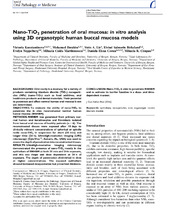Nano-TiO2 penetration of oral mucosa: in vitro analysis using 3D organotypic human buccal mucosa models
Konstantinova, Victoria; Ibrahim, Mohamed; Lie, Stein Atle; Birkeland Salmorin, Eivind; Neppelberg, Evelyn; Marthinussen Cuida, Mihaela; Costea, Daniela Elena; Cimpan, Mihaela Roxana
Peer reviewed, Journal article
Published version

Åpne
Permanent lenke
https://hdl.handle.net/1956/15331Utgivelsesdato
2016Metadata
Vis full innførselSamlinger
Originalversjon
https://doi.org/10.1111/jop.12469Sammendrag
BACKGROUND: Oral cavity is a doorway for a variety of products containing titanium dioxide (TiO2) nanoparticles (NPs) (nano-TiO2) such as food additives, oral healthcare products and dental materials. Their potential to penetrate and affect normal human oral mucosa is not yet determined. OBJECTIVES: To evaluate the ability of nano-TiO2 to penetrate the in vitro reconstructed normal human buccal mucosa (RNHBM). METHODS: RNHBM was generated from primary normal human oral keratinocytes and fibroblasts isolated from buccal oral mucosa of healthy patients (n = 6). The reconstructed tissues were exposed after 10 days to clinically relevant concentrations of spherical or spindle rutile nano-TiO2 in suspension for short (20 min) and longer time (24 h). Ultrahigh-resolution imaging (URI) microscopy (CytoVivaTM, Auburn, AL, USA) was used to assess the depth of penetration into reconstructed tissues. RESULTS: Ultrahigh-resolution imaging microscopy demonstrated the presence of nano-TiO2 mostly in the epithelium of RNHBM at both 20 min and 24-h exposure, and this was shape and doze dependent at 24 h of exposure. The depth of penetration diminished in time at higher concentrations. The exposed epithelium showed increased desquamation but preserved thickness. CONCLUSION: Nano-TiO2 is able to penetrate RNHBM and to activate its barrier function in a doze- and timedependent manner.
